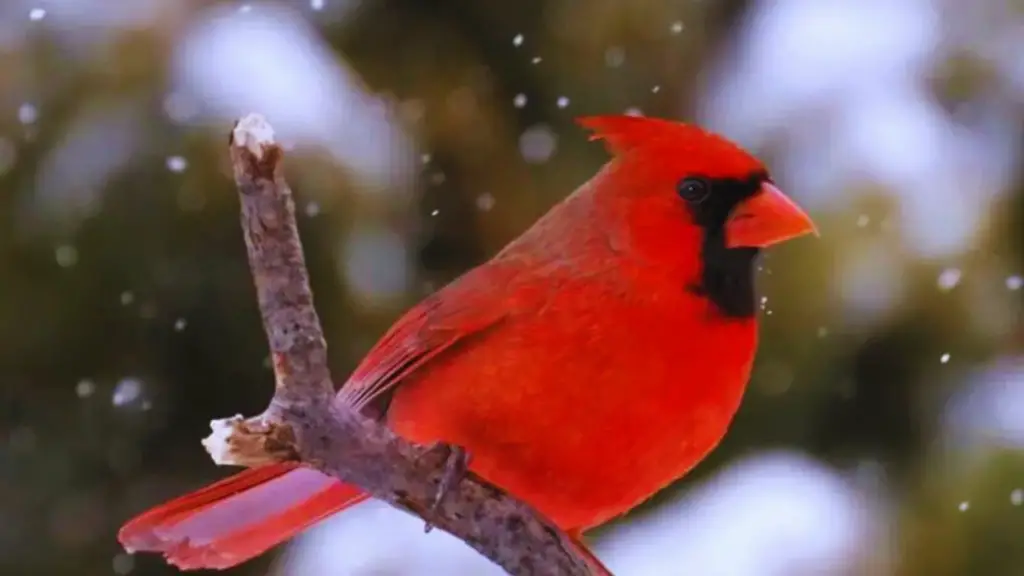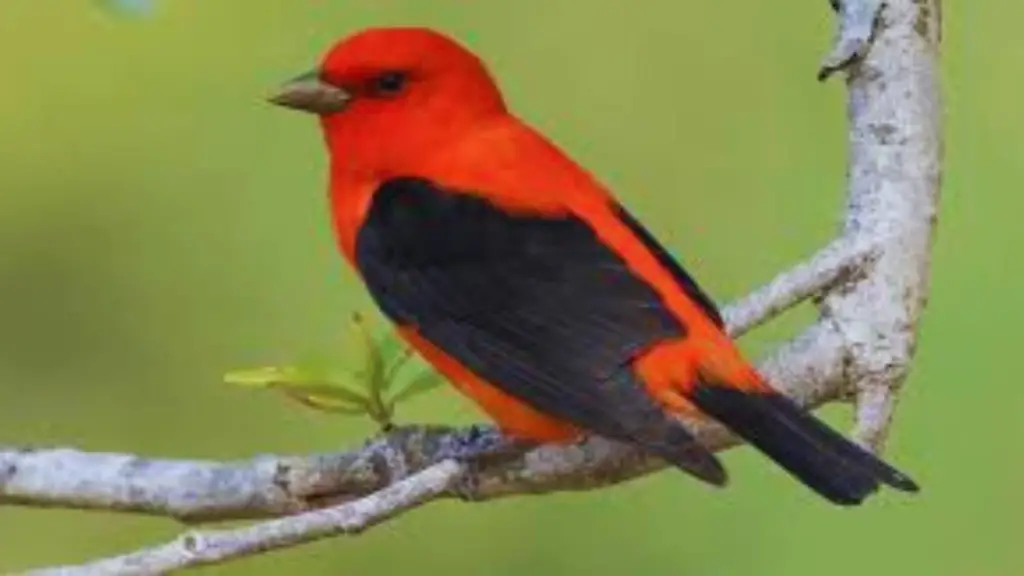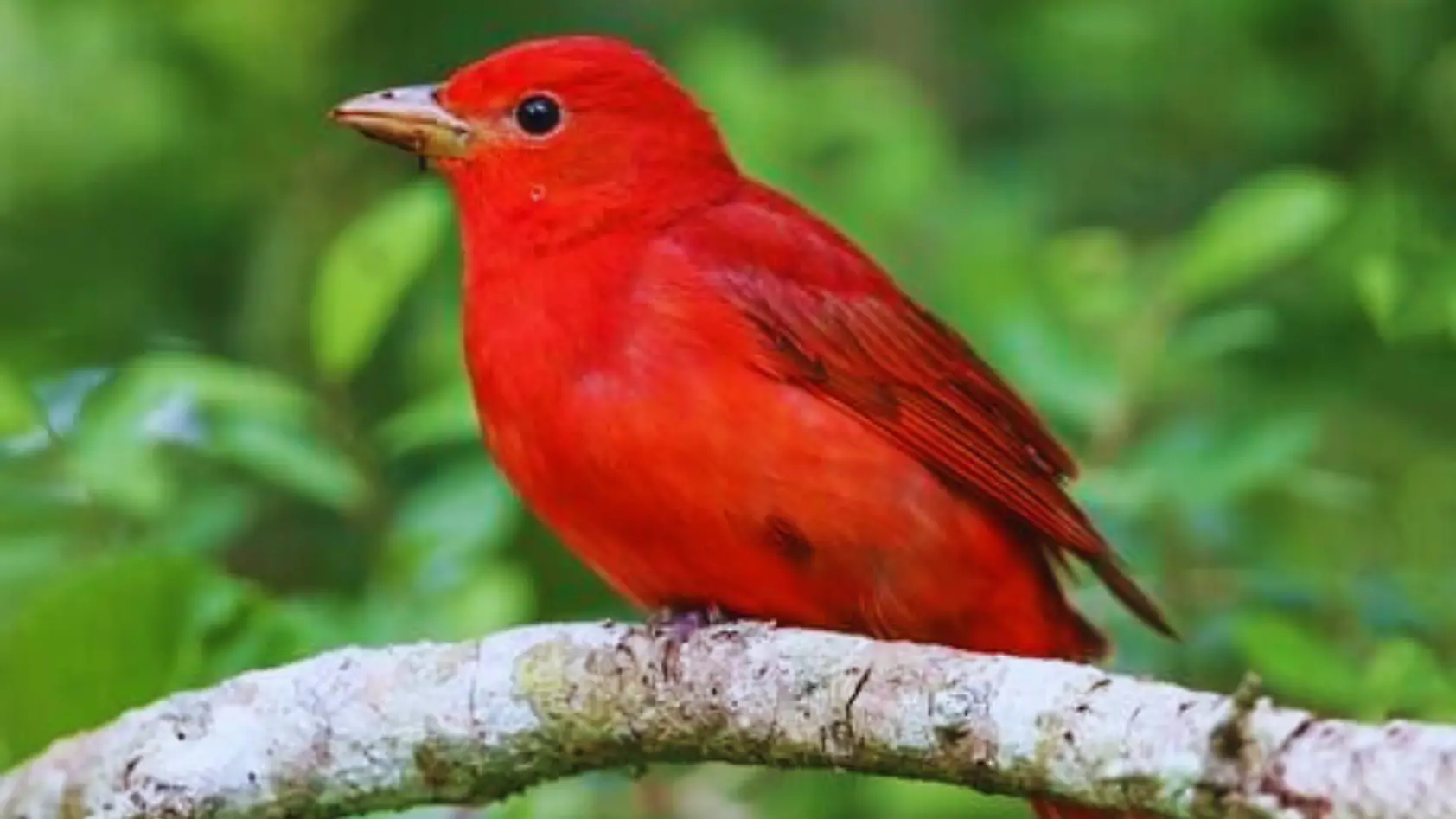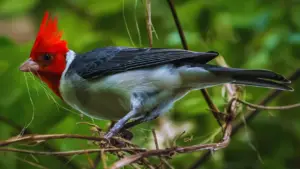If you’re a bird enthusiast, Alabama is the perfect destination to spot vibrant red birds in their natural habitats. With its diverse ecosystems and rich wildlife, the state offers ample opportunities for birdwatchers to observe and appreciate these beautiful creatures.
In this article, we’ll provide you with a comprehensive guide to spotting red birds in Alabama, including the different species you can expect to see, their preferred habitats, and tips for respectful birdwatching. Whether you’re a seasoned birder or a beginner, this guide will help you make the most of your birding experience in Alabama.
Key Takeaways
- Alabama offers a diverse range of habitats where red birds can be found, such as forests, woodlands, and wetlands.
- The Northern Cardinal is a year-round resident of Alabama, and the state bird.
- The Scarlet Tanager and Summer Tanager are red bird species that pass through Alabama during migration.
- Birding hotspots in Alabama include popular parks, wildlife refuges, and natural areas known for their diverse bird populations.
- Respectful birdwatching practices should be followed to minimize disturbance to birds and their habitats.
Alabama’s Diverse Red Bird Species

Alabama is home to a wide variety of vibrant red bird species that are a delight for bird enthusiasts to observe. The Northern Cardinal, with its bright red plumage, is perhaps the most iconic of the Alabama red birds. Other species that can be spotted in the region include the Scarlet Tanager and the Summer Tanager, both of which have distinctive physical characteristics and behavior patterns. These and other red bird species provide a colorful addition to Alabama’s varied avian population.
Alabama’s Northern Cardinal
The Northern Cardinal is a year-round resident of Alabama, and its bright red coloration and distinctive song make it a favorite among birdwatchers. These birds can be found in wooded areas throughout the state, including parks and residential areas. Cardinals are known for their preference for sunflower seeds, as well as their tendency to mate for life and defend their territory throughout the year.
Alabama’s Scarlet Tanager
The Scarlet Tanager is a transient beauty that passes through Alabama during migration season. Males of the species are a striking deep red color, while females are a more subdued yellow-green. These birds prefer forested areas with large trees, and are known for their ability to camouflage themselves among the leaves. The Scarlet Tanager is an important insect predator that helps control populations of pests in its environment.
Alabama’s Summer Tanager
The Summer Tanager spends its summers in Alabama, and is known for its distinctive red coloration. These birds prefer woodland habitats, and can often be found in the upper canopy of deciduous trees. Summer Tanagers feed primarily on insects, using their sharp bills to capture prey on the fly. These birds play an important role in maintaining a healthy ecosystem.
Habitats of Red Birds in Alabama
Alabama is home to a diverse range of habitats that provide ideal conditions for different species of red birds. From dense forests to open grasslands, these habitats offer a range of opportunities for birdwatchers to spot vibrant red birds in their natural settings.
The Northern Cardinal, for instance, is commonly found in woodlands, gardens, and suburban areas throughout the state. This bird species prefers a mixture of shrubs, trees, and understory plants for feeding and nesting.
Forests
Forests are ideal habitats for many red bird species in Alabama, including the Scarlet Tanager and Summer Tanager. These birds prefer mature forests with dense canopy cover, where they can feed on insects and fruits.
The Scarlet Tanager, with its striking red and black plumage, is often found in the upper canopy of deciduous trees in forested areas. The Summer Tanager, on the other hand, prefers open woodlands with a mixture of trees and shrubs, where it feeds on insects and spiders.
Wetlands
Wetlands, such as marshes and swamps, are important habitats for many red birds in Alabama. These areas provide abundant food sources, such as insects, small fish, and amphibians, for birds like the Northern Cardinal and Red-winged Blackbird.
The Northern Cardinal is commonly found in wetland areas with dense understory vegetation, such as shrubs and vines. The Red-winged Blackbird, with its distinctive red and yellow wing patches, is often seen perching on cattails and other emergent vegetation in wetland areas.
Grasslands
Grasslands, including agricultural fields and prairies, are favored habitats for some red bird species in Alabama. The Eastern Meadowlark, for example, is commonly found in grassy fields with scattered shrubs and trees.
The vibrant male Vermilion Flycatcher, with its bright red head and breast, can often be seen perched on fence posts and wires in open grassland areas. This bird species feeds on insects, such as grasshoppers and beetles, caught in mid-air.
By exploring these different habitats, birdwatchers in Alabama can enjoy spotting a variety of red bird species and appreciate their unique features and behaviors in their natural environments.
Red Bird Migration Patterns in Alabama
Red birds in Alabama are known for their unique migration patterns, as many species travel through the state during the spring and fall. Weather patterns, food availability, and breeding cycles all have a significant impact on the timing of their migration.
| Species | Arrival | Departure |
|---|---|---|
| Northern Cardinal | Year-round | N/A |
| Scarlet Tanager | April | September |
| Summer Tanager | April | August |
The Northern Cardinal is the only red bird species that stays in Alabama year-round, while the Scarlet Tanager and Summer Tanager are transient visitors. During their migration, these birds often stop over in key locations throughout the state to rest and refuel.
“Alabama is an important stopover site for many migratory bird species, including several types of red birds. It’s crucial that we protect their habitats to ensure their survival.”
Some of the best places to observe migrating red birds in Alabama include national wildlife refuges, state parks, and birding hotspots such as the Wheeler National Wildlife Refuge and Gulf State Park.
Whether you’re a seasoned birder or a curious nature enthusiast, observing red bird migration patterns in Alabama is a truly awe-inspiring experience.
The Northern Cardinal – Alabama’s Iconic Red Bird

The Northern Cardinal is perhaps the most well-known and beloved of all the red bird species found in Alabama. With its vibrant red plumage and distinctive crest, it is a sight to behold in any backyard or natural setting.
Cardinals can be found throughout the state, as they are year-round residents. They prefer woodland areas with dense shrubbery, as this provides them with ample cover to hide from predators.
One of the most fascinating features of the Northern Cardinal is its diet. While they do eat seeds and fruits, they are also avid insect hunters, preying on grasshoppers, beetles, and other pests that can damage crops. In this way, they play an important role in controlling insect populations and protecting crops.
When it comes to nesting, cardinal pairs work together to build a cup-shaped nest made of twigs, grasses, and other plant materials. These nests are typically built in dense shrubbery or vines, and both males and females take turns incubating the eggs and feeding the young.
Finally, the Northern Cardinal holds a special place in the hearts of Alabamians, as it was designated as the state bird in 1939. Its bright red plumage and sweet, clear song make it a beloved symbol of Alabama’s natural beauty.
Scarlet Tanager – A Transient Beauty in Alabama

If you’re lucky enough to visit Alabama during the spring or fall migration, keep an eye out for the magnificent Scarlet Tanager. These beautiful red birds are known for their bright scarlet plumage and jet-black wings. Males have a bright red body, while females have a more muted yellow-green hue.
Scarlet Tanagers prefer to inhabit deciduous forests, where they can find a mix of oak, hickory, and maple trees. During migration, they can often be spotted in wooded areas, especially near water sources.
In addition to their striking appearance, Scarlet Tanagers are also important members of the ecosystem. They primarily eat insects, including beetles, ants, and grasshoppers, making them valuable contributors to pest control.
Despite their beauty and ecological significance, Scarlet Tanager populations have been declining in recent years due to habitat loss and fragmentation. In Alabama, efforts are underway to protect their habitat and promote conservation through public education and advocacy.
If you’re lucky enough to spot a Scarlet Tanager during your visit to Alabama, be sure to observe from a respectful distance and avoid disturbing their natural behavior. These stunning birds are a true sight to behold and a key part of Alabama’s diverse birding landscape.
Where to Spot Red Birds in Alabama
If you’re hoping to catch a glimpse of some of Alabama’s vibrant red bird species, there are numerous birding hotspots throughout the state where you can observe them in their natural habitats. Here is a list of some of the top locations for spotting red birds in Alabama:
| Location | Red Bird Species |
|---|---|
| Wheeler National Wildlife Refuge | Northern Cardinal, Scarlet Tanager, Summer Tanager |
| Cheaha State Park | Northern Cardinal, Scarlet Tanager, Summer Tanager |
| Bankhead National Forest | Northern Cardinal, Scarlet Tanager, Summer Tanager |
| Little River Canyon National Preserve | Summer Tanager |
| Fort Morgan Peninsula | Northern Cardinal |
There are also numerous parks and natural areas throughout the state that offer excellent birdwatching opportunities. Keep in mind that some locations may be more accessible during certain times of the year, so it’s always a good idea to do some research before planning your trip.
Where to Spot Red Birds in Alabama
Alabama is a birding enthusiast’s paradise with a wealth of natural beauty and diverse habitats. Whether you’re a seasoned birdwatcher or a beginner, the state offers numerous opportunities to spot red birds.
Here are some of the best places to observe red birds in Alabama:
| Park/Wildlife Area | Location | Red Bird Species |
|---|---|---|
| Cheaha State Park | Talladega County | Northern Cardinal, Scarlet Tanager, Summer Tanager |
| Wheeler National Wildlife Refuge | Decatur | Northern Cardinal, Scarlet Tanager, Summer Tanager |
| Sipsey Wilderness | Lawrence, Winston, and Franklin counties | Northern Cardinal, Scarlet Tanager, Summer Tanager |
| Bon Secour National Wildlife Refuge | Gulf Shores | Scarlet Tanager |
| Dauphin Island | Mobile Bay | Summer Tanager |
In addition to these locations, other popular birding spots in Alabama include the Gulf Coast, Bankhead National Forest, and the Wheeler Wildlife Refuge. Don’t forget to bring your binoculars and a birding guidebook to help identify the different species.
Birdwatching Etiquette
While exploring Alabama’s birds and wildlife, it’s important to respect their habitats and minimize your impact on their behavior. Here are some birdwatching etiquette tips to keep in mind:
- Stay on designated trails and paths to avoid disrupting nests or habitats.
- Do not use recorded bird calls to attract birds as it can disrupt their communication and nesting patterns.
- Do not feed birds as it can interfere with their natural diet and behavior.
- Keep noise levels low to avoid startling birds.
- Always follow park and wildlife area regulations and guidelines.
By following these guidelines, you can help protect Alabama’s beautiful red birds and their habitats for future generations.
Red Bird Conservation Efforts in Alabama

Alabama is home to a diverse range of red bird species, and as such, conservation efforts are essential in protecting their habitats and ensuring their continued survival. Various organizations and initiatives are working towards this goal in the state.
The Alabama Audubon Society is one such organization that is actively involved in promoting bird conservation through education, research, and advocacy. They offer numerous resources and programs for bird enthusiasts, including bird walks, field trips, and citizen science projects focused on tracking bird populations and their habitats.
The Alabama Wildlife Federation is another organization that plays a vital role in preserving the natural habitats of Alabama’s red bird species. They work towards conserving public lands, promoting sustainable land use practices, and partnering with other organizations to achieve their goals.
In addition to these organizations, state and federal agencies, such as the Alabama Department of Conservation and Natural Resources and the U.S. Fish and Wildlife Service, work towards preserving and protecting endangered or threatened species, including red bird species.
It is crucial for birdwatchers and visitors to Alabama to be mindful of their impact on the natural world and to adhere to responsible birding practices. Avoid trampling on vegetation or disturbing nesting birds during the breeding season. Stick to designated trails and areas, and avoid using audio playback to attract birds. By being respectful and responsible, we can all contribute to the conservation efforts of Alabama’s red bird species.
Birdwatching Tips and Etiquette in Alabama
If you’re planning on birdwatching in Alabama, there are a few tips and guidelines you should keep in mind to ensure you have a safe, enjoyable, and respectful experience.
- Bring binoculars: A good pair of binoculars will allow you to observe birds from a distance without disturbing them.
- Be patient: Birds can be elusive and may take time to appear. Give yourself enough time to wait for them.
- Respect bird habitats and nesting sites: Do not approach nesting birds or disturb their habitats, as this can cause them to abandon their nests.
- Stay on designated trails: Do not wander off designated paths, as this can damage fragile ecosystems and plants.
- Don’t feed the birds: Feeding birds can interfere with their natural feeding patterns and attract unwanted predators.
Additionally, it is essential to be mindful of other birdwatchers and nature enthusiasts in the area. Follow proper birdwatching etiquette by respecting others’ space and avoiding loud noises or sudden movements that can startle the birds.
Other Red Bird Species Found in the Southern United States
While Alabama is home to many vibrant red bird species, there are other stunning birds to be found in the southern United States. Here are some species you may encounter during your birdwatching adventures around the region:
| Species | Habitat | Description |
|---|---|---|
| Vermilion Flycatcher | Grasslands and savannas | A small bird with bright red plumage and a distinctive crest. Males have a black mask and a reddish bill. |
| Summer Tanager | Forests | A medium-sized bird with bright red plumage and a thick bill. Females are yellow-green with some red markings. |
| Red-headed Woodpecker | Forests and woodlands | A medium-sized woodpecker with red plumage on its head and neck. The rest of its body is mostly black and white. |
Keep an eye out for these and other colorful birds during your birdwatching travels in the southern United States. You never know what you might spot!
Alabama’s Birding Events and Festivals
If you’re a birdwatching enthusiast, you don’t want to miss out on the various birding events and festivals held annually in Alabama. These events provide an excellent opportunity to connect with like-minded bird lovers, learn more about bird species and habitats in the state, and participate in guided birdwalks and educational talks.
Some of the popular events include:
- The Birmingham Audubon Society’s Spring Fling, held in April, which features field trips to birding hotspots, workshops, and a keynote address by a renowned bird expert.
- The Dauphin Island Bird Sanctuary’s Spring Bird Count, held in May, which invites participants to help with the annual count of migrating birds.
- The Alabama Coastal BirdFest, held in October, which offers a wide range of activities, including birdwalks, boat tours, and trolley rides to birding sites along the coast.
These events are open to bird enthusiasts of all levels and ages and provide a unique opportunity to experience the vibrant birdlife in Alabama.
Photographing Red Birds in Alabama

If you’re an avid bird photographer visiting Alabama, you’re in for a treat. The state offers plenty of opportunities to capture stunning photographs of its vibrant red bird species. Here are some tips to help you get the perfect shot:
1. Use a Fast Shutter Speed
Red birds, especially those in flight, can be challenging to capture without motion blur. Using a fast shutter speed of at least 1/1000th of a second can help freeze the action and produce sharp images.
2. Consider Lighting Conditions
The right lighting can make a world of difference in photography. When photographing red birds, try to capture them in soft, diffused light, as direct sunlight can wash out their vibrant colors. Early morning or late afternoon light can be particularly flattering.
3. Get Close, But Not Too Close
Getting close to your subjects can help capture fine details and produce more intimate portraits. However, it’s important not to disturb or stress the birds in the process. Use a telephoto lens to maintain a safe distance and avoid disrupting their natural behavior.
4. Pay Attention to Composition
Composition can make or break a photograph. Consider factors such as background, foreground, and framing when setting up your shot. Try to position the bird in a way that creates a pleasing and balanced composition.
5. Be Patient and Respectful
Patience and respect are essential when photographing wildlife. Observe the birds from a distance and wait for them to come to you, rather than chasing or harassing them. Remember that their well-being should always come before your desire for a photograph.
With these tips in mind, you’re well on your way to capturing memorable photographs of Alabama’s stunning red bird species.
Conclusion
In conclusion, Alabama offers a colorful array of red bird species that are cherished by bird lovers across the United States. From the iconic Northern Cardinal to the transient Scarlet Tanager and the summer visitor Summer Tanager, Alabama’s habitats provide a home to diverse bird populations.
To spot these beautiful birds, you can explore birding hotspots such as parks, wildlife refuges, and natural areas. However, it’s important to practice respectful birdwatching etiquette to minimize disturbance to birds and their habitats. Additionally, you can join annual birding events and festivals to interact with other bird enthusiasts and learn more about these fascinating creatures.
Finally, remember to capture the memories of your birdwatching experiences with photographs of these striking red birds. With the right camera settings, lighting, and composition techniques, you can create meaningful and lasting images of Alabama’s vibrant wildlife.
FAQs About Red Birds in Alabama
Q: How many red bird species can be found in Alabama?
A: Alabama is home to a variety of red bird species, including the Northern Cardinal, Scarlet Tanager, and Summer Tanager.
Q: Where can I spot red birds in Alabama?
A: Red birds can be found in various habitats across Alabama, such as forests, woodlands, and wetlands. Popular birding hotspots in the state include parks, wildlife refuges, and natural areas.
Q: When do red birds migrate in Alabama?
A: Red birds have specific migration patterns in Alabama, with arrival and departure timings varying for different species. Some locations in the state serve as stopovers or nesting grounds during migration.
Q: What are some conservation efforts for red birds in Alabama?
A: There are several organizations and initiatives in Alabama working towards conserving red bird species and their habitats. These efforts aim to raise awareness about their importance and ensure their survival in the state.
Q: Are there any birdwatching events or festivals in Alabama?
A: Yes, Alabama hosts annual birding events and festivals where enthusiasts can join guided birdwalks, attend educational talks, and connect with other bird lovers in the state.
Q: What are some tips for photographing red birds in Alabama?
A: To capture memorable photographs of red birds in Alabama, consider using appropriate camera settings, taking lighting conditions into account, and utilizing composition techniques specific to bird photography.














